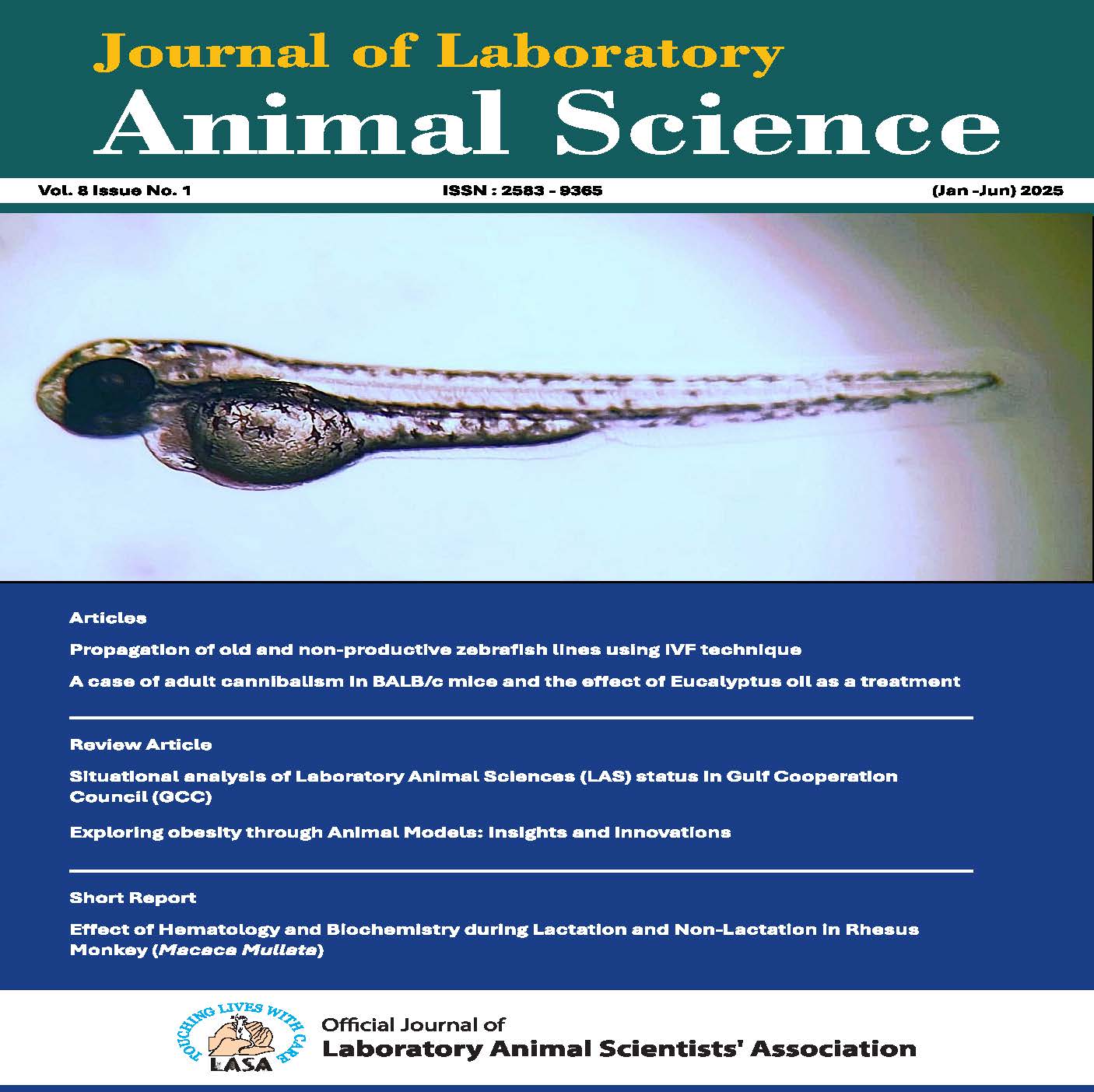Comparison of selected clinical pathology analytes in two outbred strains of Rats at different ages
DOI:
https://doi.org/10.48165/jlas.2025.8.2.1Keywords:
Hematology , Biochemistry, Wistar, SD, AgeAbstract
Outbred rats are laboratory animals widely used in preclinical research and investigation of clinical pathology parameters is an important part of the preclinical evaluation of drug safety. The objective of the present study was to determine the influence of strain and age on selected haematological and biochemical analytes in Sprague Dawley (Crl:CD[SD]) and Wistar (Crl:WI[Han]) rats. Selected analytes were studied in 390 rats per strain with an equal representation of both sexes at 6-8 weeks, 10-14 weeks and 6-10 months of age. The data were statistically compared to assess the changes in relation to age and strain. The distribution of results by strain showed that SD rats of both sexes had significantly higher values of MCHC, PLT, WBC, LYMPH and AST, ALT concentration, while male Wistar rats had significantly higher values of RBC, E% and female Wistar rats had N% and UREA concentration. The distribution of the results according to age showed that the increase in the age of the rats significantly reduced the MCV, MCH, PLT, L%, and the concentration of AST, ALP. The concentration of GLU, TP, CREA and percentage of neutrophil and eosinophil significantly increased with the increasing age of rats. In conclusion, this research demonstrated that age and strain significantly influence most of the hematological and biochemical parameters of outbred rats.
Downloads
References
1. Alemán CL, Más RM, Rodeiro I, et al. (1998). Reference database of the main physiological parameters in Sprague Dawley rats from 6 to 32 months. Lab Anim. 32(4):457-466. https://10.1258/002367798780599802
2. Boehm O, Zur B, Koch A, Tran N, Freyenhagen R, Hartmann M, et al. (2007). Clinical chemistry reference database for Wistar rats and C57/BL6 mice. Biol Chem. 388(5):547-54
3. Bryda EC (2013). The Mighty Mouse: the impact of rodents on advances in biomedical research. Mo Med, 110, 207-211. 4. Delwatta SL, Gunatilake M, Baumans V, et al. (2018). Reference values for selected hematological, biochemical, and physiological parameters of Sprague-Dawley rats at the Animal House, Faculty of Medicine, University of Colombo, Sri Lanka. Animal Model Exp Med. 2018;1(4):250-254. https://10.1002/ame2.12041
5. de Kort M, Weber K, Wimmer B, Wilutzky K, Neuenhahn P, Allingham P, et al. (2020). Historical control data for hematology parameters obtained from toxicity studies per formed on different Wistar rat strains: Acceptable value ranges, definition of severity degrees, and vehicle effects. Toxicol Res and App. 4.
6. Ghezzi AC, Cambri LT, Botezelli JD, Ribeiro C, Dalia RA, de Mello MA (2012). Metabolic syndrome markers in Wistar rats of different ages. Diabetol Metab Syndr 4(1):16. https://10.1186/1758-5996-4-16
7. Giknis MLA, Clifford CB (2006). Clinical laboratory parameter for Crl: CD (SD). Charles River Laboratories. https://www.criver.com/sites/default/files/resources/rm_ rm_r_clinical_parameters_cd_rat_06.pdf
8. Giknis MLA, Clifford CB (2008). Clinical laboratory parameter for Crl: WI(Han). Charles River Laboratories. https://www.criver.com/sites/default/files/resources/rm_ rm_r_Wistar_Han_clin_lab_parameters_08.pdf
9. Hayakawa K, Mimura Y, Tachibana S, et al. (2013). Study for collecting background data on Wistar Hannover [Crl: WI(Han)] rats in general toxicity studies--comparative data to Sprague Dawley rats. J Toxicol Sci. 38(6):855-873. https://10.2131/jts.38.855
10. He Q, Su G, Liu K, et al. (2017). Sex-specific reference inter vals of hematologic and biochemical analytes in Sprague Dawley rats using the nonparametric rank percentile method. PLoS One. 12(12):e0189837. https://10.1371/jour nal.pone.0189837
11. Horn PS, Pesce AJ. (2003). Reference intervals: an update. Clin Chim Acta. 334(1-2):5-23. https://10.1016/s0009- 8981(03)00133-5
12. Jacob Filho W, Lima CC, Paunksnis MRR, Silva AA, Perilhão MS, Caldeira M, et al. (2018). Reference database of hematological parameters for growing and aging rats. Aging Male 21(2):145-8
13. Jones CI (2016). Platelet function and aging. Mamm Genome. 2016;27(7-8):358-366. https://10.1007/s00335- 016-9629-8
14. Kampfmann I, Bauer NB, Johannes S, Moritz A (2012). Differences in hematologic variables in rats of the same strain but different origin. Vet Clin Pathol. 41(2); 228-34.
15. Koolhaas JM (2010). The Laboratory Rat. In: The UFAW Handbook on the Care and Management of Laboratory and Other Research Animals, 311-326.
16. Krinke GJ ed (2000). The Laboratory Rat. San Diego, CA: Academic Press; 2000
17. Okamura T, Suzuki S, Ogawa T, et al. (2011). Background Data for General Toxicology Parameters in RccHan:WIST Rats at 8, 10, 19 and 32 Weeks of Age. J Toxicol Pathol. 2011;24(4):195-205. https://10.1293/tox.24.195
18. Özturk B, Çiftçi İ, Ecer B, Gökyaprak SM, Eryavuz Onmaz D (2021). Biochemical and hematological profiles of wistar rats at the Selcuk University experimental medicine research and application center. Eurasian J Vet Sci. 37(4):259-4.
19. Patel S, Patel S, Kotadiya A, et al. (2024). Age-related changes in hematological and biochemical profiles of Wistar rats. Lab Anim Res. 40(1):7. https://10.1186/s42826- 024-00194-7
20. Petterino C, Argentino-Storino A (2006). Clinical chemistry and haematology historical data in control Sprague-Dawley rats from pre-clinical toxicity studies. Exp Toxicol Pathol. 57(3):213±9. https://doi.org/10.1016/j.etp.2005.10.002
21. Suckow MA, Weisbroth SH, Franklin CL (2006). The Laboratory Rat. 2nd ed. Amsterdam, The Netherlands: Academic Press.
22. Van Zutphen LFM, Baumans V, Beynen AC (2001). Principles of Laboratory Animal Science, Revised Edition: a Contribution to the Humane Use and Care of Animals and to the Quality of Experimental Resu. The Netherlands: Elsevier.
23. Wolford ST, Schroer RA, Gohs FX, Gallo PP (1986). Reference range data base for serum chemistry and hema tology values in laboratory animals. J Toxicol Environ Health. 18(2): 161-88.
24. Wolford ST, Schroer RA, Gallo PP, et al. (1987). Age related changes in serum chemistry and hematology values in normal Sprague-Dawley rats. Fundam Appl Toxicol. 8(1):80-88. https://10.1016/0272-0590(87)90102-3
25. Zhong-Ze Han, Hong-De Xu and Kwang-Ho Kim et al. (2010). Reference Data of the Main Physiological Parameters in Control Sprague-Dawley Rats from Pre clinical Toxicity Studies. Laboratory Animal Research. Vol. 26(2):153. https://10.5625/lar.2010.26.2.153

